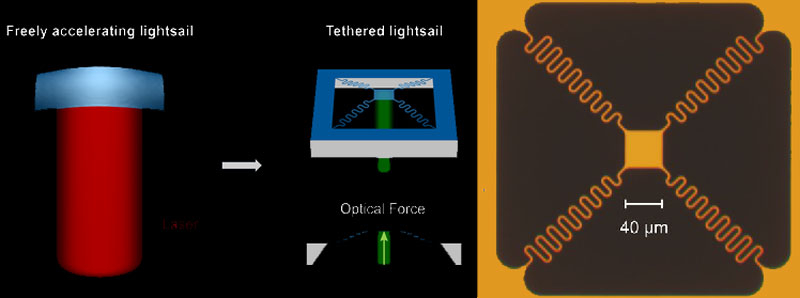Scientists from the California Technological Institute (Caltech) have created a stand for studying materials for a solar (light) sail, potentially capable of delivering probes to other stars and systems. We have already learned how to make miniature probes, but with sails a problem. They are imposed quite harsh requirements, which necessitates deep scientific research. A stand for testing materials created in the United States will help to go this path.

Image source: CALTECH
The idea to use the light sail and powerful lasers from the Earth or out of space was finally formed in 2016, when the spouses Yuri and Julia Milner financed the Breakthrough Initiatives project, enlisting the support of the world -famous physicist Stephen Hawking. Scientific work on the project was headed by the California Technological Institute. Creating a platform on the basis of Kaltha for testing materials for light sails was a logical continuation of work in that area.
For researchers, it was important to cut off the thermal influence on the samples of the laser beam – the external drive of the sail – from the thermal radiation created by him, as well as from external interference. The power of the laser light pressure as part of the stand is so small (it will be relatively small) that even a simple conversation near the installation interfered with the dimensions. Ultimately, using an argon laser, it was possible to create a platform in a vacuum chamber that would make the effect of photons on the material of the samples.
«When developing a membrane, which ultimately could be used as a light sail, there are many problems. It should withstand heating, maintaining the shape under pressure and steadily move along the laser beam axis, ”the scientists say. – But before we can start creating such a sail, we need to understand how the materials react to the influence of laser radiation. We wanted to know if we can determine the force acting on the membrane, simply measuring its movement. It turns out we can. “
To evaluate the displacement of sail samples under the influence of light pressure, two rays were used – supporting and measuring deviations. For this, scientists have collected an interferometer in a microscope. Why in a microscope? The sizes of samples are only 40 × 40 microns, so you can not do without a microscope to work with them.

The sample is fixed in the frame on spring stretch marks. The sample can be rotated at the right angle to the laser rays, imitating various conditions of flight and maneuvers, as well as receiving information about the distribution of force that exerts light pressure on the sail. Obviously, in the flight, the sail can change the angle in relation to the ray pushing it. It is important to return it to the course, which, incidentally, can be done automatically if you use metamathals on the inner surface of the sail, which, for example, will give it a reverse rotation to return to the course of light.
The pressure created by the laser on the tiny membrane of silicon nitride shifted it to several pickloses. Previously, silicon nitride was already considered as promising material for the light sail. The new work showed that its properties can be literally studied under a microscope, collecting a full set of data necessary for the future implementation of a large -scale project.
By the way, it is not necessary to fly to the alpha center. A small probe with a solar sail today could serve science, providing assistance in finding the ninth planet in the solar system somewhere on its distant outskirts, which many indirect facts are hinting at. And that would be an amazing story.